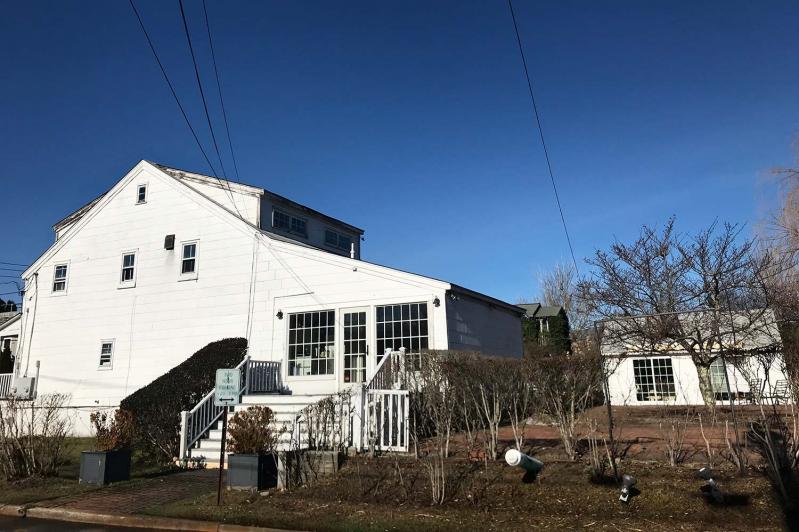Since Adam Potter first created his 11 Bridge Street Limited Liability Company in December 2020 and made clear his intentions to construct a large mixed-use building including housing and retail on five parcels of land bound by Meadow, Rose, and Bridge Streets in Sag Harbor Village, several criticisms have been leveled against the project. The loudest and most consistent objections have been made over traffic, parking, flooding, and environmental concerns.
At the Dec. 20 Sag Harbor Village Planning Board meeting at which Mr. Potter unveiled his latest iteration of his plan, he said, “I have addressed all of the concerns by the people opposing the project,” and highlighted alterations he made to make it more palatable to critics. Some might debate whether their concerns have been allayed, however, one thing isn’t debatable: Mr. Potter’s stated need to remove several buildings that contribute to the village’s historic district, which is listed on the National Register of Historic Places, to remediate the land and water beneath them. The Sag Harbor Village Historic District comprises 870 structures and was expanded in 1994, after it was originally recognized in 1973.
In the cross hairs are four structures that, according to village code, are not to be removed. “The only reason any building would go off that list is typically not through demolition, because one of the highest responsibilities of the local government is preserving those structures,” Zach Studenroth, a historic preservation consultant who has worked with the village’s board of historic preservation and architectural review since 2015, said in a phone call. “There have been some fires.” (The Sag Harbor Village Building Department does not keep a record of which structures, if any, have been removed.)
The first, at 23 Bridge Street, was built between 1905 and 1910, and includes a contributing shop building that faces Rose Street. Mr. Studenroth believes it to be “considerably older,” though he admitted he has yet to gain entrance to the building to conform his suspicion. Two more, at 8 and 12 Rose Street, were built in 1910, according to the register. Another, at 7 Bridge Street, while not currently in the district, is considered historic by the New York State Historic Preservation Office and is eligible for inclusion if the district expands.
“We have a choice,” said Mr. Potter to the planning board. “What is more important? Three or four structures that contribute to the historic district? Or cleaning up the land and water for all of Sag Harbor?” He slighted the structures themselves, hinting strongly, in a recent phone call, that there wasn’t anything special about them. “Those are not historic buildings. Those are buildings that contribute to the historic district, there’s a big difference,” he said. “When people say historic, the visual is of a quaint stone cottage or huge mansion that’s been around forever. When you look at these structures, you’re like, ‘that’s a dump.’ ”
“People get confused about whether a building is more historical than another,” said Mr. Studenroth. “The Whaling Museum and John Jermain Library are architecturally imposing, and obvious, whereas others might seem to be rather unremarkable. But that’s not historical, that’s a judgement. The National Register doesn’t bring judgement to the discussion. As far as the register is concerned, they are all of equal merit.”
“The idea of whacking them down is so repugnant and against what Sag Harbor is all about,” Nancy Achenbach, the president of the Sag Harbor Historical Museum, said in a phone call. “The integrity of Sag Harbor lies in its downtown, and the old houses.”
In 2021, Sloane Bullough, a historic sites restoration coordinator for the New York State Historic Preservation Office, wrote a letter regarding Mr. Potter’s then-larger proposal suggesting he either reuse the buildings, incorporate them into the site, or find another location for his project. At the December planning board meeting he took up one of Ms. Bullough’s suggestions.
“I’ll commit right now, if anybody wants these buildings, I will pay to move them to any other site in Sag Harbor,” Mr. Potter said at the planning board meeting.
“Moving a building is generally considered to be detrimental to it,” said Mr. Studenroth. “Part of a history of a building is its context. What if you moved the library down to the waterfront? A building gathers significance from its location. The district is defined not only by its components, but the relationships they have to each other. There will be more modest buildings in certain places, for example a flood plain, versus South Main Street, which was always fashionable. There is a whole historical evolution of the village.”
“There’s a fundamental difference if something is still standing or it isn’t,” he continued. “The question is what happens when we subtract buildings. At what point is subtracting a problem? Rather than asking when we should stop, instead the question is why should we start?”
“The condition of the buildings does not sustain our ability to reuse them,” said Mr. Potter. “And look what National Grid had to do with the gas-ball lot and 31 Long Island Avenue. In order to remediate the land, they had to take down the buildings. At the end of the day, it’s a choice.”




